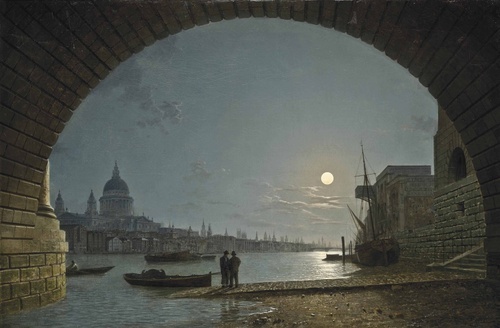

Henry Pether
GB
26
Artworks
1800 - 1880
Lifespan
Artist Biography
Henry Pether (February 1800 – 20 February 1880) was a distinguished English landscape painter, celebrated for his evocative moonlit scenes of 19th-century Britain, Paris, and Venice. Born into an artistic lineage, his father, Abraham Pether, and older brother, Sebastian Pether, were also known for their nocturnal paintings, collectively earning them the moniker "Moonlight Pethers." Henry, however, carved his own niche with a style noted for its superior realism, meticulous detail, refined atmosphere, and sophisticated colouring, often signing his works to distinguish them from his family members whose pieces sometimes leaned towards the imaginary or featured different tonal qualities.
Pether's artistic focus was predominantly on landscapes and townscapes under the enchanting glow of the moon. He was particularly drawn to the River Thames, producing many iconic views between 1850 and 1865, such as his detailed depiction of Greenwich Hospital. His repertoire extended beyond London, capturing the nocturnal beauty of Paris, Venice, and various locations in Scotland. Works like "Twickenham by Moonlight" exemplify his ability to merge the English picturesque style with the romanticism of artists like Caspar David Friedrich, creating a contemplative and hermetic mood through the masterful interplay of light and shadow. His paintings, such as "St. Paul’s Cathedral from Blackfriars Bridge" and "Venice by Moonlight," are lauded for their topographical accuracy and the deeply atmospheric quality that invites viewers into a silent, sleeping city.
Throughout his career, Pether exhibited his paintings at prestigious institutions including the Royal Academy (between 1828 and 1862), the British Institution, and the Royal Society of British Artists. Today, his works are held in esteemed collections such as Tate Britain, the City of London, Royal Museums Greenwich, the National Gallery of Victoria, and the Yale Center for British Art. Critics highlight three characteristic features in his work: the prominent role of significant architecture, the masterful use of illumination (primarily moonlight, often complemented by subtle artificial lights), and the crucial presence of water, which reflects and amplifies the ethereal light, enhancing the scene's depth and mood.
Despite his artistic talents, Pether faced significant financial challenges throughout his life, leading him to diversify his professions. In 1837, he was listed as an inmate in a debtor's prison, described not only as an artist but also as a surveyor, engineer, and architect. This necessity likely fueled his inventive pursuits; he applied for patents for lamps, architectural materials, and tiles, with his mosaic tiles being exhibited at the Great Exhibition of 1851. He lived in various locations, including Camden, Clapham, and Southampton, possibly moving to evade creditors. He was married to Sarah and had three children.
Henry Pether's meticulous and time-consuming artistic process meant he was not a prolific painter, which, ironically, may have contributed to the demand for his work and the subsequent proliferation of imitations and misattributions, a problem that persists today. His influence is notably seen in the later work of John Atkinson Grimshaw, who emulated Pether's nocturnes. Pether's dedication to accuracy and his ability to evoke a darkly poetic Romanticism, presenting unpopulated or sparsely populated cityscapes, offer a private, almost clandestine view of the urban environment. His legacy endures through his authentic, carefully rendered paintings that continue to captivate audiences with their serene, moon-drenched beauty and historical insight.